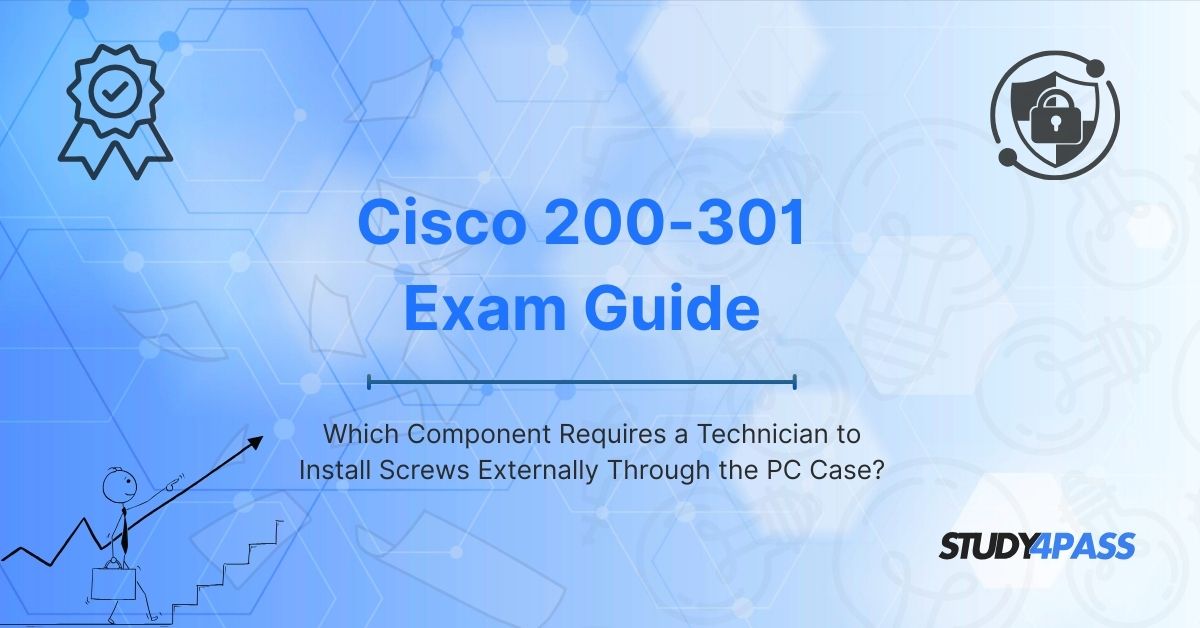Introduction To Cisco 200-301 Exam Guide
When building or upgrading a PC, understanding hardware installation is crucial especially for IT professionals preparing for certifications like the Cisco 200-301 exam. One common question that arises is: Which component requires a technician to install screws externally through the PC case?
In this comprehensive Cisco 200-301 Exam Guide, we’ll explore the answer in detail, along with key insights into PC hardware, installation best practices, and how this knowledge applies to networking and IT certifications.
Understanding PC Case and Component Installation
Before identifying the specific component, let’s briefly discuss how PC cases are designed and how components are mounted.
1. Types of PC Cases
Tower Cases (Full, Mid, Mini): Common for desktops, offering varying space for components.
Small Form Factor (SFF): Compact cases for space efficiency.
Rackmount Cases: Used in servers and networking equipment.
2. Internal vs. External Mounting
Internal Mounting: Components like the motherboard, GPU, and RAM are secured inside the case.
External Mounting: Some components require screws to be fastened from the outside.
Which Component Requires External Screws?
The component that typically requires external screw installation through the PC case is the Power Supply Unit (PSU).
Why the PSU Needs External Screws
1. Mounting Position:
- PSUs are usually mounted at the rearbottom or reartop of the case.
- They have screw holes that align with the case’s PSU bracket.
2. Securing the PSU:
- Four screws (sometimes more) are inserted from the outside of the case into the PSU.
- This ensures stability and prevents movement that could damage internal components. =
3. Ventilation & Safety:
- External screws help maintain proper airflow.
- They ensure the PSU fan is correctly aligned with the case’s ventilation holes.
Other Components That May Use External Screws
While the PSU is the primary component requiring external screws, others may also need them:
- Case Fans: Some cases have externally mounted fans.
- Expansion Slot Covers: Used to secure PCIe brackets.
- Optical Drives (in older cases): Required screws from the side.
- StepbyStep Guide: Installing a PSU with External Screws
For those preparing for the Cisco 200-301 Exam, handson hardware knowledge is valuable. Here’s how to install a PSU correctly:
1. Choose the Right PSU
Ensure compatibility with your case (ATX, SFX, etc.).
Check wattage requirements for your system.
2. Align the PSU with the Case
Position the PSU so the fan faces the case’s ventilation area.
Match screw holes on the PSU with those on the case.
3. Insert Screws from the Outside
Use the provided screws (usually coarsethreaded).
Tighten diagonally to ensure even pressure.
4. Connect Power Cables
Attach the 24pin motherboard connector.
Connect CPU, GPU, and SATA power cables as needed.
5. Test the Installation
Power on the PC to ensure the PSU functions correctly.
Why This Matters for the Cisco 200301 Exam
The Cisco 200-301 Certification (CCNA certification) covers networking fundamentals, but hardware knowledge is still essential because:
1. Network Devices Use Similar Concepts:
Routers, switches, and servers also require proper mounting.
Understanding screw placements helps with rack installations.
2. Troubleshooting Hardware Issues:
A loose PSU can cause power failures knowing how to secure it prevents downtime.
3. RealWorld IT Skills:
Many IT roles involve assembling and maintaining hardware.
Common Mistakes When Installing a PSU
Avoid these errors to ensure a stable system:
- Using Wrong Screws:
- PSU screws are often larger than motherboard screws.
- Overtightening:
- Can strip threads or damage the case.
- Incorrect Fan Orientation:
- Blocks airflow, leading to overheating.
Conclusion
Knowing which component requires a technician to install screws externally through the PC case (the Power Supply Unit) is a fundamental skill for IT professionals and those studying for the Cisco 200-301 exam. Proper installation ensures system stability, safety, and longevity.
Special Discount: Offer Valid For Limited Time “Cisco 200-301 Exam”
Sample Questions for Cisco 200-301 Exam Prep Practice Tests
Actual exam question from Cisco's 200-301 Exam Prep Practice Test
Which of the following is a primary resource recommended for preparing for the Cisco 200-301 CCNA exam?
A) Cisco 200-301 Official Cert Guide Library by Wendell Odom
B) CompTIA Network+ Study Guide by Todd Lammle
C) AWS Certified Solutions Architect Official Guide
D) Microsoft Azure Fundamentals Exam Ref


